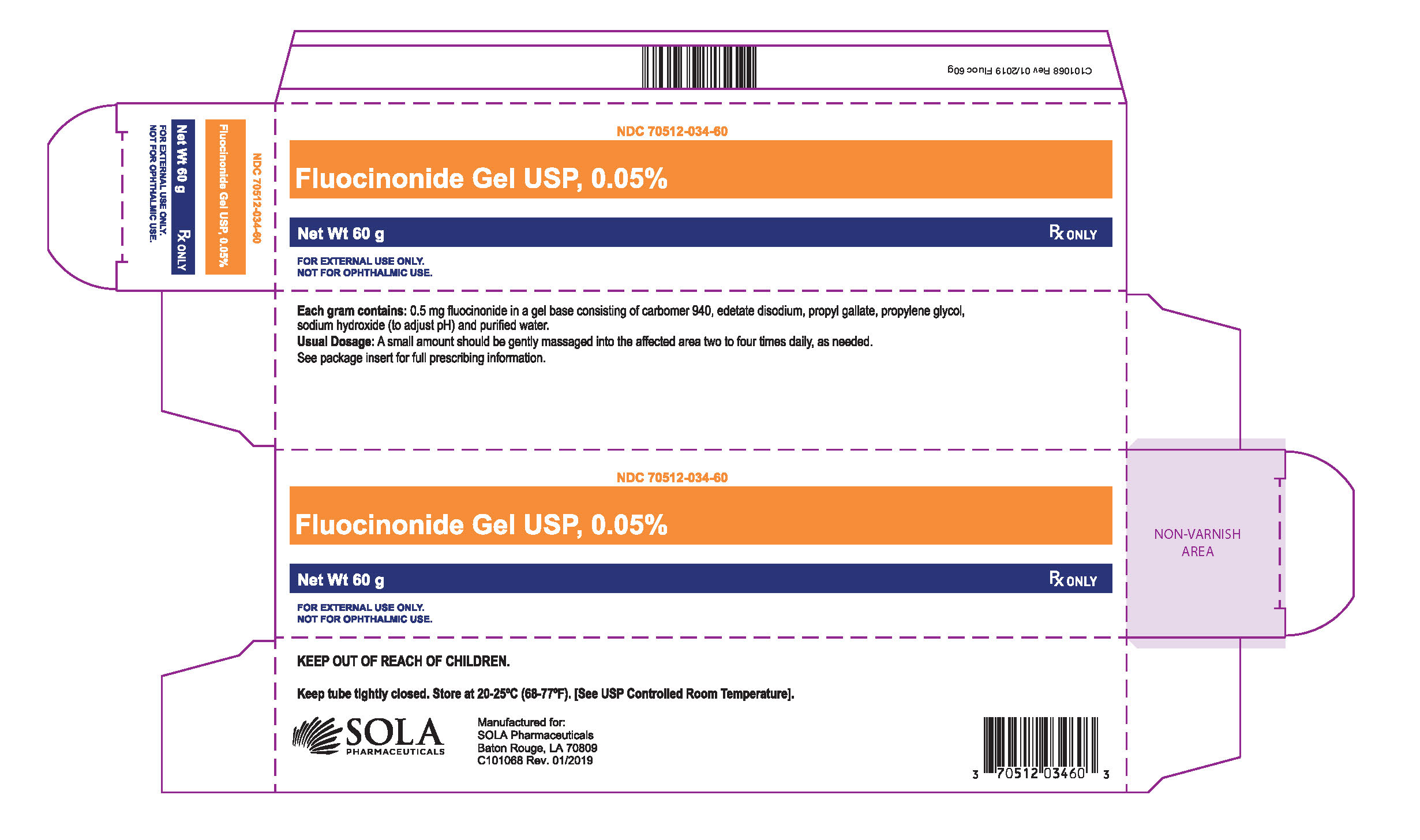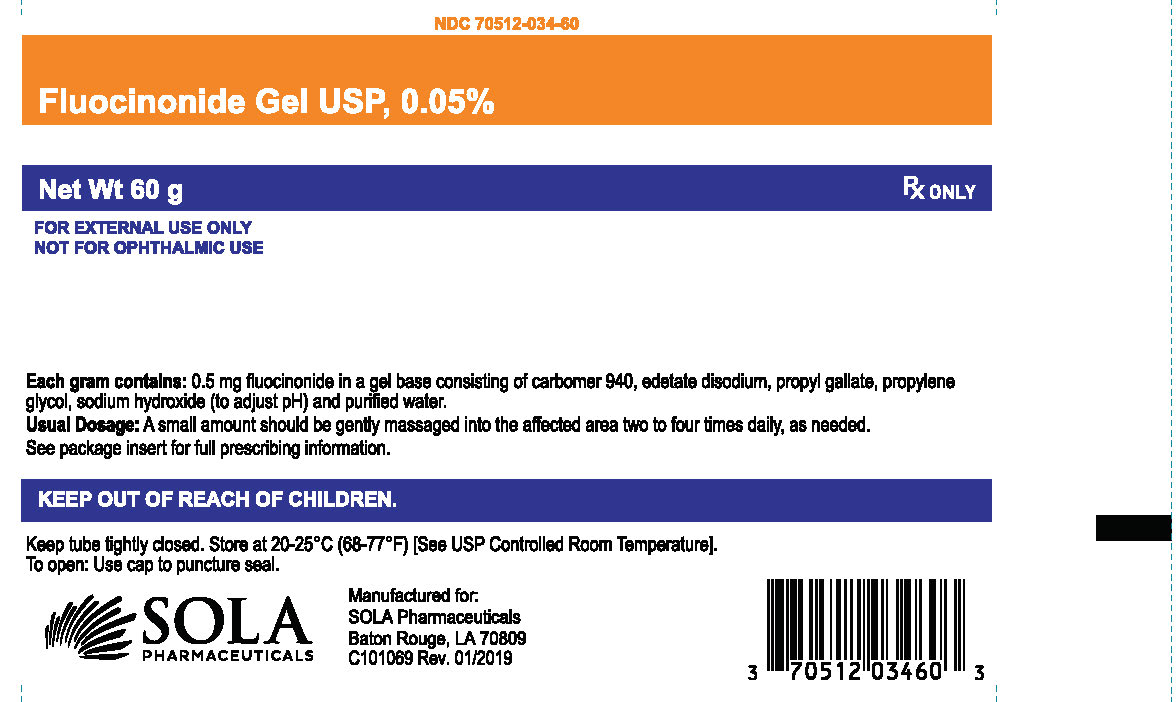Fluocinonide Gel by SOLA Pharmaceuticals FLUOCINONIDE GEL gel
Fluocinonide Gel by
Drug Labeling and Warnings
Fluocinonide Gel by is a Prescription medication manufactured, distributed, or labeled by SOLA Pharmaceuticals. Drug facts, warnings, and ingredients follow.
Drug Details [pdf]
-
Description
Fluocinonide Gel USP, 0.05% is intended for topical administration. The active component is the corticosteroid fluocinonide, which is the 21-acetate ester of fluocinolone acetonide and has the chemical name pregna-1,4-diene-3,20-dione,21-(acetyloxy) -6,9-difluoro-11-hydroxy-16,17-[(1-methylethylidene)bis(oxy)]-,(6a,11b,16a)-. It has the following chemical structure:

Fluocinonide Gel USP, 0.05% contains fluocinonide 0.5 mg/g in a specially formulated gel base consisting of carbomer 940, edetate disodium, propyl gallate, propylene glycol, sodium hydroxide (to adjust pH) and purified water. This clear, colorless, thixotropic vehicle is greaseless, non-staining and completely water miscible.
In the Fluocinonide Gel USP, 0.05% formulation, the active ingredient is totally in solution. -
Clinical Pharmacology
Topical corticosteroids share anti-inflammatory, anti-pruritic and vasoconstrictive actions.
The mechanism of anti-inflammatory activity of the topical corticosteroids is unclear. Various laboratory methods, including vasoconstrictor assays, are used to compare and predict potencies and/or clinical efficacies of the topical corticosteroids. There is some evidence to suggest that a recognizable correlation exists between vasoconstrictor potency and therapeutic efficacy in man.
Pharmacokinetics
The extent of percutaneous absorption of topical corticosteroids is determined by many factors including the vehicle, the integrity of the epidermal barrier, and the use of occlusive dressings. Topical corticosteroids can be absorbed from normal intact skin. Inflammation and/or other disease processes in the skin increase percutaneous absorption. Occlusive dressings substantially increase the percutaneous absorption of topical corticosteroids. Thus, occlusive dressings may be a valuable therapeutic adjunct for treatment of resistant dermatoses (see DOSAGE AND ADMINISTRATION). Once absorbed through the skin, topical corticosteroids are handled through pharmacokinetic pathways similar to systemically administered corticosteroids. Corticosteroids are bound to plasma proteins in varying degrees. Corticosteroids are metabolized primarily in the liver and are then excreted by the kidneys. Some of the topical corticosteroids and their metabolites are also excreted into the bile. - Indication and Usage
- Contraindication
-
Precaution
General
Systemic absorption of topical corticosteroids has produced reversible hypothalamic-pituitary-adrenal (HPA) axis suppression, manifestations of Cushing's syndrome, hyperglycemia, and glucosuria in some patients.
Conditions which augment systemic absorption include the application of the more potent steroids, use over large surface areas, prolonged use, and the addition of occlusive dressings.
Therefore, patients receiving a large dose of a potent topical steroid applied to a large surface area or under an occlusive dressing should be evaluated periodically for evidence of HPA axis suppression by using the urinary free cortisol and ACTH stimulation tests. If HPA axis suppression is noted, an attempt should be made to withdraw the drug, to reduce the frequency of application, or to substitute a less potent steroid.
Recovery of HPA axis function is generally prompt and complete upon discontinuation of the drug. Infrequently, signs and symptoms of steroid withdrawal may occur, requiring supplemental systemic corticosteroids.
Children may absorb proportionally larger amounts of topical corticosteroids and thus be more susceptible to systemic toxicity (see PRECAUTIONS - Pediatric Use). If irritation develops, topical corticosteroids should be discontinued and appropriate therapy instituted.
As with any topical corticosteroid product, prolonged use may produce atrophy of the skin and subcutaneous tissues. When used on intertriginous or flexor areas, or on the face, this may occur even with short-term use.
In the presence of dermatological infections, the use of an appropriate antifungal or antibacterial agent should be instituted. If a favorable response does not occur promptly, the corticosteroid should be discontinued until the infection has been adequately controlled.Information for the Patient
Patients using topical corticosteroids should receive the following information and instructions:
1. This medication is to be used as directed by the physician. It is for external use only. Avoid contact with the eyes.
2. Patients should be advised not to use this medication for any disorder other than for which it was prescribed.
3. The treated skin area should not be bandaged or otherwise covered or wrapped as to be occlusive unless directed by the physician.
4. Patients should report any signs of local adverse reactions, especially under occlusive dressing.
5. Parents of pediatric patients should be advised not to use tight-fitting diapers or plastic pants on a child being treated in the diaper area, as these garments may constitute occlusive dressings.Laboratory Tests
The following tests may be helpful in evaluating the HPA axis suppression:Urinary free cortisol test
ACTH stimulation test
Carcinogenesis, Mutagenesis, and Impairment of Fertility
Long-term animal studies have not been performed to evaluate the carcinogenic potential or the effect on fertility of topical corticosteroids.
Studies to determine mutagenicity with prednisolone and hydrocortisone have revealed negative results.
Pregnancy Category C
Corticosteroids are generally teratogenic in laboratory animals when administered systemically at relatively low dosage levels. The more potent corticosteroids have been shown to be teratogenic after dermal application in laboratory animals. There are no adequate and well-controlled studies in pregnant women on teratogenic effects from topically applied corticosteroids. Therefore, topical corticosteroids should be used during pregnancy only if the potential benefit justifies the potential risk
to the fetus. Drugs of this class should not be used extensively on pregnant patients, in large amounts, or for prolonged periods of time.
Nursing Mothers
It is not known whether topical administration of corticosteroids could result in sufficient systemic absorption to produce detectable quantities in breast milk. Systemically administered corticosteroids are secreted into breast milk in quantities not likely to have a deleterious effect on the infant. Nevertheless, caution should be exercised when topical corticosteroids are administered to a nursing woman.
Pediatric Use
Pediatric patients may demonstrate greater susceptibility to topical corticosteroid-induced hypothalamic- pituitary-adrenal (HPA) axis suppression and Cushing's syndrome than mature patients because of a larger skin surface area to body weight ratio.
HPA axis suppression, Cushing's syndrome, and intracranial hypertension have been reported in children receiving topical corticosteroids. Manifestations of adrenal suppression in children include linear growth retardation, delayed weight gain, low plasma cortisol levels, and absence of response to ACTH stimulation. Manifestations of intracranial hypertension include bulging fontanelles, headaches, and bilateral papilledema.
Administration of topical corticosteroids to children should be limited to the least amount compatible with an effective therapeutic regimen. Chronic corticosteroid therapy may interfere with the growth and development of children.
-
Adverse Reactions
The following local adverse reactions are reported infrequently with topical corticosteroids, but may occur more frequently with the use of occlusive dressings. These reactions are listed in an approximate decreasing order of occurrence:Burning
Itching
Irritation
Dryness
FolliculitisHypertrichosis
Acneiform Eruptions
Hypopigmentation
Perioral Dermatitis
Allergic Contact DermatitisMaceration of the Skin
Secondary Infection
Skin AtrophyStriae
Miliari
To report SUSPECTED ADVERSE REACTIONS contact Teligent Pharma, Inc. at 856-697-1441 or
FDA at 1-800-FDA-1088 or www.fda.gov/medwatch. - Overdosage
-
Dosage and Administration
Fluocinonide Gel USP, 0.05% is generally applied to the affected area as a thin film from two to four times daily depending on the severity of the condition.
Occlusive dressings may be used for the management of psoriasis or recalcitrant conditions.
If an infection develops, the use of occlusive dressings should be discontinued and appropriate antimicrobial therapy instituted. -
How Supplied
Fluocinonide Gel USP, 0.05% is supplied in the following
60g (NDC: 70512-034-60) tubes.
Store at 20°- 25°C (68°- 77°F) [see USP Controlled Room Temperature].
Manufactured for:
Sola PharmaceuticalsBaton Rouge, LA 70809
C101070 Rev. 01/2019
-
Package Label
NDC: 70512-034-60
Fluocinonide Gel USP, 0.05%
Net Wt 60g
Rx Only
FOR EXTERNAL USE ONLY.
NOT FOR OPHTHALMIC USE.

-
INGREDIENTS AND APPEARANCE
FLUOCINONIDE GEL
fluocinonide gel gelProduct Information Product Type HUMAN PRESCRIPTION DRUG Item Code (Source) NDC: 70512-034 Route of Administration TOPICAL Active Ingredient/Active Moiety Ingredient Name Basis of Strength Strength FLUOCINONIDE (UNII: 2W4A77YPAN) (FLUOCINONIDE - UNII:2W4A77YPAN) FLUOCINONIDE 0.5 mg in 1 g Inactive Ingredients Ingredient Name Strength CARBOMER HOMOPOLYMER TYPE C (UNII: 4Q93RCW27E) PROPYL GALLATE (UNII: 8D4SNN7V92) WATER (UNII: 059QF0KO0R) EDETATE DISODIUM (UNII: 7FLD91C86K) PROPYLENE GLYCOL (UNII: 6DC9Q167V3) SODIUM HYDROXIDE (UNII: 55X04QC32I) Packaging # Item Code Package Description Marketing Start Date Marketing End Date 1 NDC: 70512-034-60 1 in 1 CARTON 02/04/2019 1 60 g in 1 TUBE; Type 0: Not a Combination Product Marketing Information Marketing Category Application Number or Monograph Citation Marketing Start Date Marketing End Date ANDA ANDA209030 02/04/2019 Labeler - SOLA Pharmaceuticals (080121345)
© 2025 FDA.report
This site is not affiliated with or endorsed by the FDA.